Part 2 of the Nemegt Fauna Series. Review and photos by Bokisaurus, edited by Suspsy
Back in 2012, the Osaka Museum Of Natural History launched an impressive special exhibit highlighting the impressive diversity of dinosaur fossils found in Mongolia’s Gobi Desert. This special exhibit was aptly named “The Gobi: Cradle of the Most Enchanting Dinosaur Fossils” and consisted of beautiful specimens of some of the most famous Mongolian dinosaurs for the public to admire. Like many special dinosaur exhibits in Japan, and there have been many of them through the years, there were museum merchandise exclusives. Of what must have been countless merchandise items, two stood out. These are the museum exclusive figures of Tarbosaurus and Saurolophus, two of the show’s star. These figures are sculpted by the famous Hirokazu Tokugawa and released by Favorite Co. Ltd.
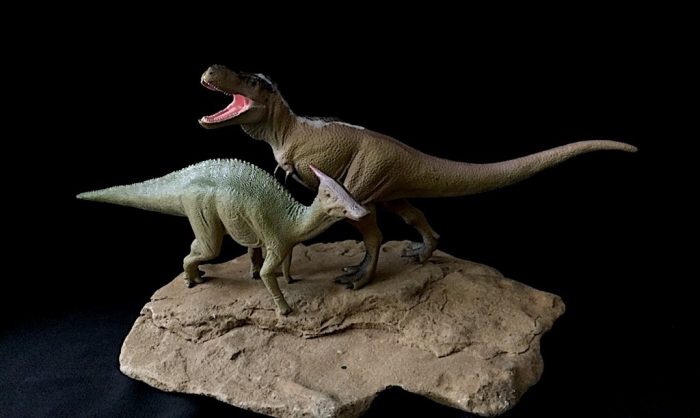
These beautifully sculpted figures drove many dinosaur collectors crazy trying to acquire them. Like many museum exclusives, they were not widely available outside of the OMNH, let alone overseas. This made the hunt to acquire them difficult and often costly. Still, with some help, a few of these figures did find its way across the globe, including my own doorstep. Today, we will review one of them, the Saurolophus.
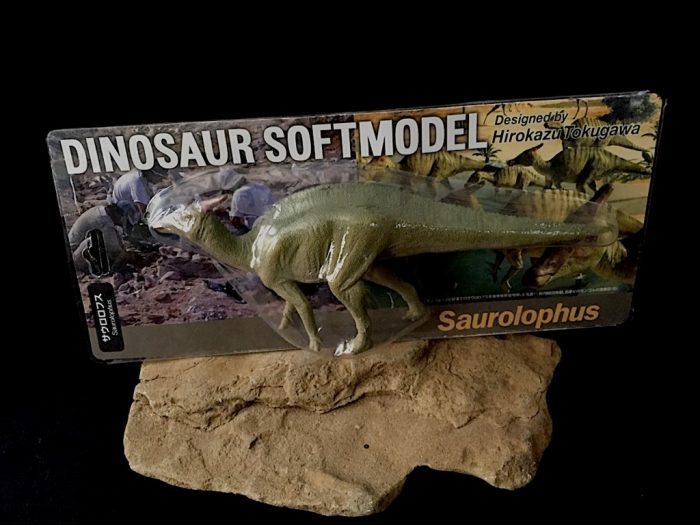
Saurolophus was a large saurolophine hadrosaurid that lived in the Late Cretaceous of what would one day be the Nemegt Formation of the Gobi Desert. It is unique in that it is one of the few hadrosaurs known from multiple continents. Two species are known to have existed. The first one discovered was the Canadian S. osborni, discovered back in 1911. The second species, S. angustirostris (which is the figure we are reviewing today), was discovered in Mongolia in 1946, and it was was much larger than its relative. It also turns out that Saurolophus is the most abundant of the Asian hadrosaurs. Its fossil record is also well documented with nearly complete skeletons, as well as various growth stages that give us a pretty good picture of its anatomy and how it may have lived.
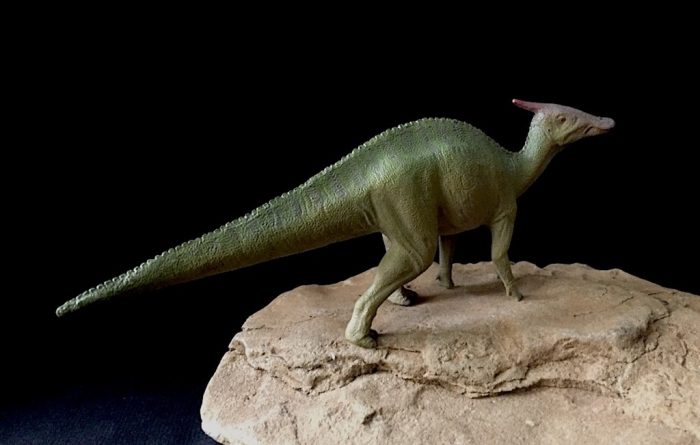
The Asian Saurolophus was much larger than its North American relative, reaching an estimated size of around 12 metres (39 feet) long, and a weight of 2 tons. At around 1:40 scale, this Favorite figure stands 3.5 inches tall and 10 inches long. Unlike its flamboyant lambeosaurine relatives, Saurolophus’ headgear was rather modest. A bony, spike-like crest extended upwards from the back of the skull. In this figure, this crest is coloured a reddish brown. At first glance, the animal looks like it is sculpted in a calm, neutral pose with a quadruped stance. However, and depending on how you view the figure, this pose can be interpreted many ways. For example, with its head tilted slightly to the side, and its left front foot off the ground, this can be perceived as a surprised individual, especially when you notice the orientation of the eyes.
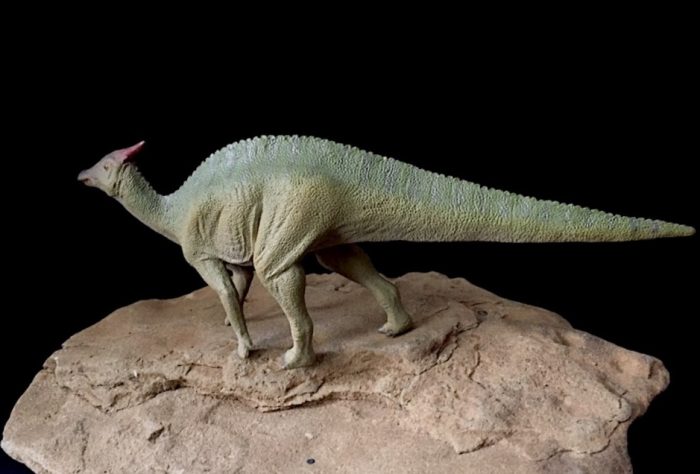
The colour scheme on this figure is dominated by olive green mixed in with some browns on the lower half, while a darker green band runs along the upper back half of the figure. There are also faint brown stripes running down the back. This may look drab, but it suits an animal that is mostly a savanna dweller. The drab colours help the animal blend in with the brown, dry vegetation that dominated the Cretaceous savanna.
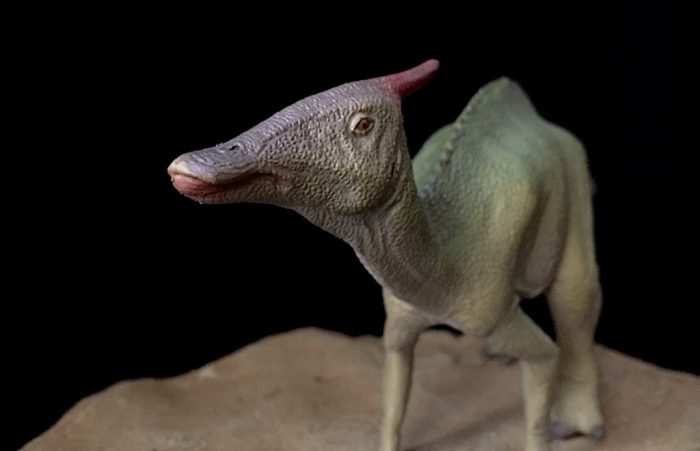
Let us again return to Mongolia’s Gobi Desert during the Late Cretaceous. A large herd of Saurolophus can be seen mixed in with an even larger herd of Gallimimus. These animals are on their annual migration and the lush woodland savanna is one of their favourite feeding ground. The Saurolophus herd breaks into smaller groups as they fan out in search of food and water. One mixed group of adult and young Saurolophus approaches one of the shallow lakes that border the forest. They have come here to take advantage of the vegetation that grows abundantly in this environment, for Saurolophus are open savanna animals. This open environment gives the animals a better view of their surroundings, and much importantly, a better opportunity to spot predators before they get too close. The open space also allows these large animals a quick escape.
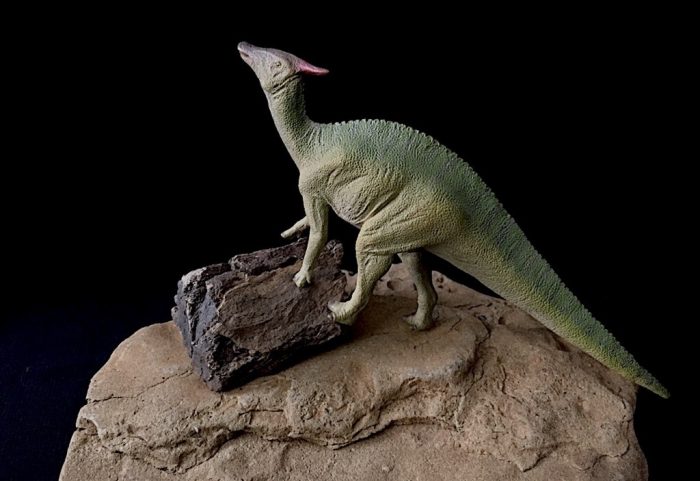
Entering the forest edge is dangerous for Saurolophus. Here the lush vegetation creates many blind spots that potentially hide predators and offer little escape routes. Still, the group approaches, the temptation is just too great to resist. One Saurolophus, a curious young female, decides to move closer into the forest. She ignores the adults’ warning cries to stay with rest of the group. Soon, she meets some of the forest’s more fascinating residents. Eyeing her with curiosity is a pair of Deinocheirus, those giant ornithomimosaurs with huge claws. They move closer and inspect this odd creature that has invaded their home. But they are not a threat to the young female, and she knows it, and they all soon settle into feeding.

Back at the forest’s edge, the peaceful scene is about to end. The wind carries the unmistakable scent of a predator. And not just any predator; this scent belongs to Tarbosaurus, the apex predator of the land! Soon, the Saurolophus herd sets off cries of alarm that echo around the forest. They regroup and run off back towards the open safety of the grassland as the Tarbosaurus charges. But he is not after the fleeing herd.
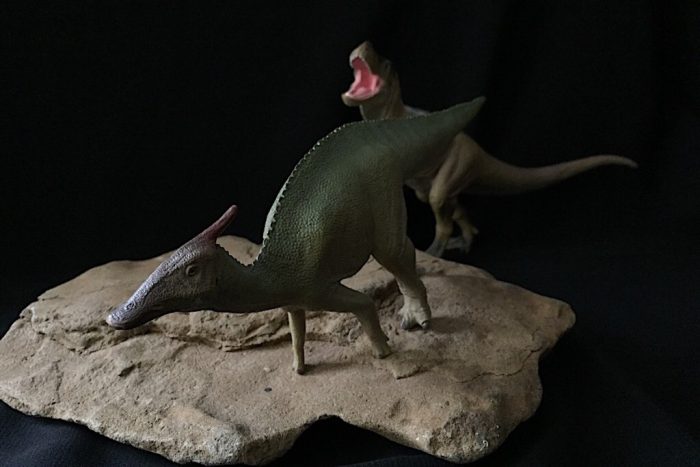
By the time our young female realizes her dire situation, it is too late. Her escape route blocked by the charging Tarbosaurus and her herd nowhere in sight, she looks towards the forest’s edge at the fleeing pair of Deinocheirus. Desperate to escape, she decides to follow the pair deeper into the forest.
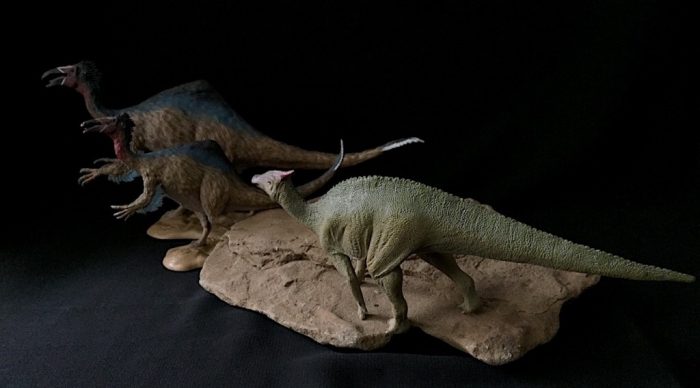
Before going very far, she is stopped on her tracks by a loud warning cry coming somewhere deep in the thickets. Soon, the source reveals itself to be a large male Therizinosaurus. Although not a predator, he is equipped with formidable claws, very much like Deinocheirus’, but even bigger. He is not after the young female Saurolophus, for he is a herbivore. However, the scent of the pursuing Tarbosaurus has sent this grumpy male into a blind rage. Unlike the more docile Deinocheirus, whose first instinct is to run from danger, Therizinosaurus charges any potential threat. With his large, deadly claws swinging in multiple directions, a hit from one of them could be fatal. He heads straight to where our female Saurolophus is standing. Trapped now between him and the charging Tarbosaurus, she quickly turns around and heads back towards the only opening between the two.
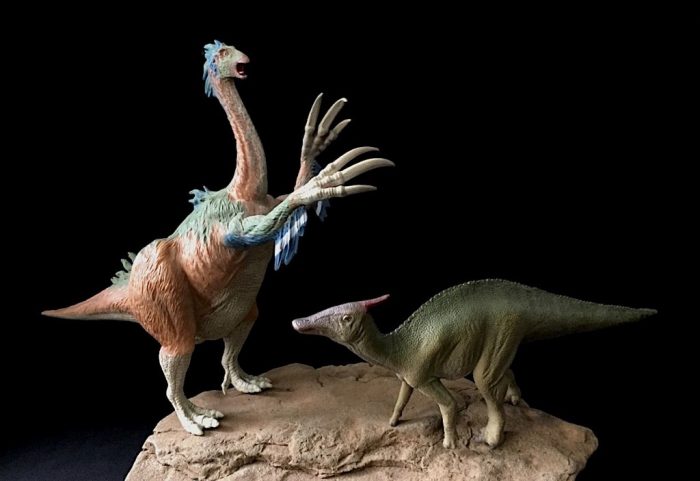
The sudden appearance of Therizinosaurus distracts Tarbosaurus from his chase, allowing the young Saurolophus enough time to slip between them and runs toward the safety of the open savanna and hopefully, her herd. She runs fast without looking back. Her only clue to what is unfolding behind her are the loud growls and shrieks echoing around the lake.
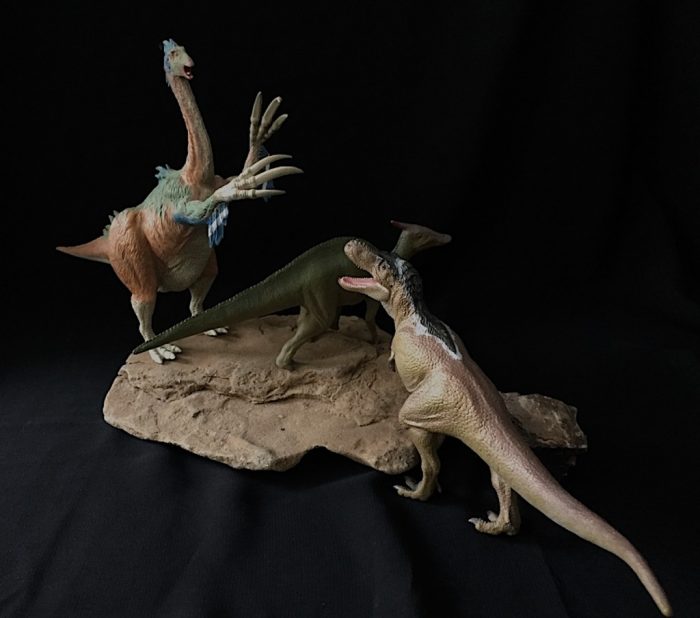
As she reaches the savanna, she finds herself in the middle of a stampeding herd of Gallimimus. The dust clouds from the stampeding herd cause her to become temporarily disoriented. The the dust clears, she finds herself face to face with Alioramus, Tarbosaurus’ smaller relative. She has stumbled upon a hunt.
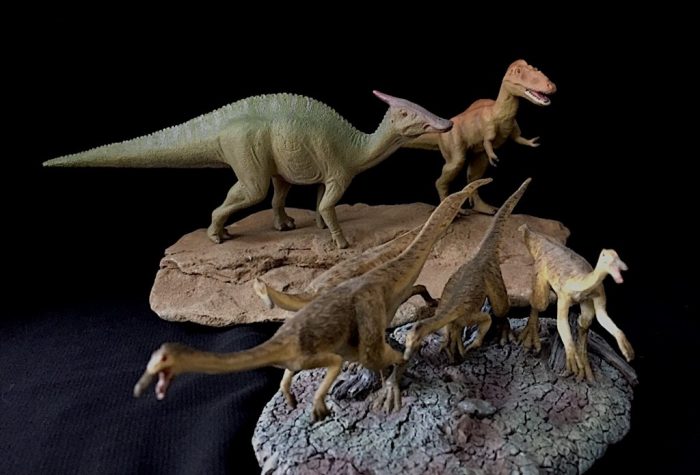
Although a formidable hunter, Alioramus is much smaller than Saurolophus. His main prey are the overaptorids and Gallimimus. Saurolophus can sometimes fall prey to Alioramus, but only the very small ones. Now almost an adult size, our female is simply too big for the predator to take down. The Alioramus simply turns away and leave the young female behind.

Our young Saurolophus scans the horizon for any sign of her herd. In the distance, she sees the familiar shapes rising like mirages. She has found her family at last. As she approaches, the adults start to call. Their loud honking sounds are welcoming and comforting to our young female. Once back in the safety of the herd, she finally looks back toward the distant lake and forest. Perhaps she does so to remember this place, and to remember both the opportunities it offered as well as the dangers hidden in its dark shadows. She will forever remember this experience, one that taught her a valuable life experience. A lesson on how to survive in this enchanting, but deceiving landscape. In time, she will pass on this knowledge to other young ones. And just like that, she turns back and rejoins her herd.
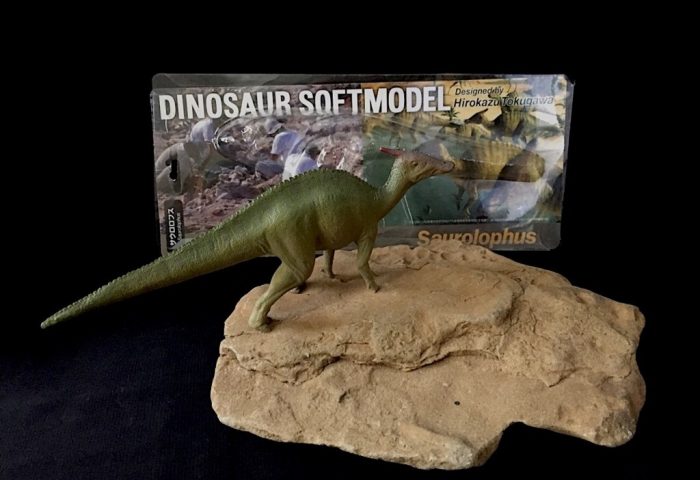
In closing, the Favorite Saurolophus figure is a must-have, especially with the shortage of good hadrosaur figures, not to mention saurolophines. The figure is very well-crafted and jam-packed with details. At 1:40 scale, it is one of the few hadrosaur figures at this size. As it was sculpted specifically as a partner for the Tarbosaurus, they do make for a beautiful display. Unfortunately, due to its very limited release, this and the Tarbosaurus are very hard figures to acquire, and often command high prices. Still, with some luck, patience, and good connections, one may be able find it at a reasonable price. I highly recommend this figure to anyone. It is truly a beautiful piece from a master artist. The figures come in blister packaging. The art design on the background shows two photos. One is a painting of a herd of Saurolophus by a shallow lake. The other half is a photo of a group of paleontologists today at a dig site.

I hope you enjoyed the review. On our next review, we will conclude the series, when we meet up with Tarbosaurus again. Until then, cheers!
Disclaimer: links to Ebay and Amazon on the DinoToyBlog are affiliate links, so we make a small commission if you use them. Thanks for supporting us!



With all its elegance, this fellow doesn’t have any pubis at all.
I know Saurolophus pubis should be small, but the curve flows too soft from the belly to the tail that it doesn’t look like the pubis are intentionally designed to be hidden in the tissues of the tail.
It looks like the sculptor forgot it totally.
That’s my only complaint.
Any opinions?
Yes, it seems to be a startling omission for such a fine figure. Looking at my Olorotitan, the pubis is not large, but is still quite visible. Otherwise , Favorite’s Saurolophus fits in very nicely, appearance and scale-wise, with my herd of PNSO hadrosaur gems.
Is it possible that the sculptor was related to Ieyasu, the famous Shogun?
[…] Fauna review trilogy by looking at the Tarbosaurus figure by Favorite Co. Ltd. As I explained in my Saurolophus review, back in 2012, the Osaka Museum Of Natural History launched an impressive special exhibit that […]
Apart from the beautiful and pleasant review, for me the saurolophus of Favorite is by far one of his best figures (but the best). And it is for me along with the one of Kaiyodo the only representatives in the toy market serious for collectors. The pity that to find them is something impossible and I do not say difficult.
As for tarbosaurus on eBay it is easy to find it without complications.
Great review!